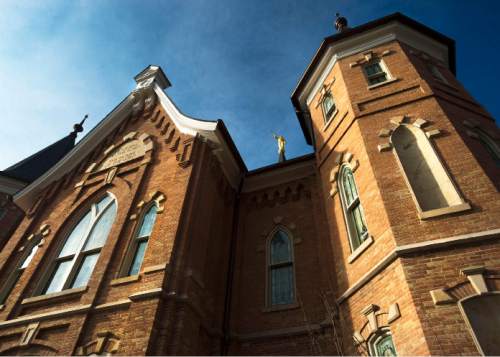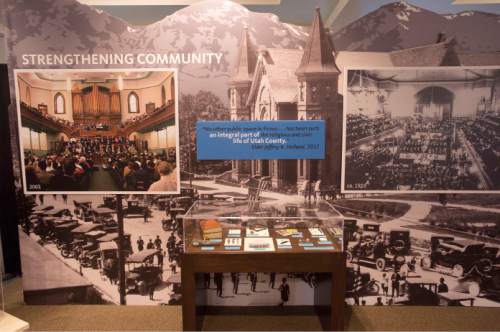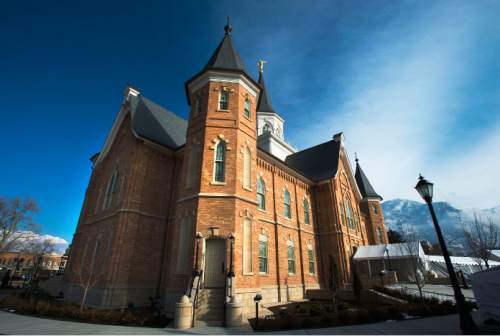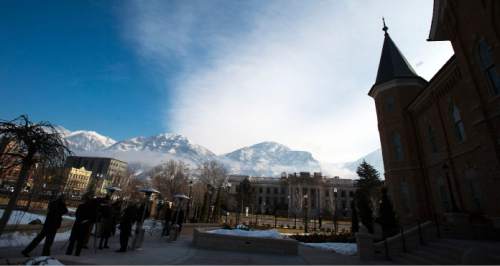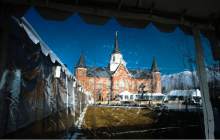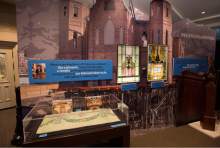This is an archived article that was published on sltrib.com in 2016, and information in the article may be outdated. It is provided only for personal research purposes and may not be reprinted.
Provo • Walking into the just-completed Provo City Center LDS Temple, you see the same richly textured furniture, woven floor coverings and floral patterns as showcased in many modern Mormon sacred structures.
This one, though, feels both new and old.
Visitors will swear they climbed the spiral staircase before. Gothic touches are everywhere — from stained-glass windows to hallway arches — and they feel, well, familiar. The African mahogany on railings, trim and door jambs gives it a historic sensibility.
That is all by design.
This is, after all, the old Provo Tabernacle, gutted by fire in December 2010, come back to life as a Mormon temple. Little remained from the original but the exterior walls and one small piece of carved wood, used now in a podium. Everything else was new or made as a replica.
"I am thrilled to witness what has happened and what has been created," Rosemary M. Wixom, general president of the church's Primary organization for children up to age 12, said Monday. The tabernacle-resurrected-as-a-temple combines "elegance, tribute and respect for the Lord."
Every aspect of the Utah-based faith, she said, is meant to "point to the Savior."
The Provo City Center Temple, when it is dedicated in March, will be the 150th operating Mormon temple in the world, with 23 more announced or in the process of being built.
"I remember as a little girl memorizing [the names of] all 13 temples in the church then," said Wixom, the only woman on the church's Temple and Family History Executive Council. "Either I'm very old or this is happening very fast. I do believe the Lord is hastening his work."
Indeed, The Church of Jesus Christ of Latter-day Saints has picked up its construction pace since 1998, when the faith had 47 temples. Two years later, it hit 100 with the opening of one in Boston.
"We are," Kent F. Richards, executive director of the faith's Temple Department, said Monday during a media preview, "a temple-building people."
The Provo Tabernacle was designed by Mormon architect William Harrison Folsom in 1882. Previously, Folsom had worked on the Manti Temple, among other projects. The tabernacle was a big open room, with space for a large gathering, and included two circular staircases up to the balcony for more seating.
In addition to weekly church services, the hall was used for civic events such as lectures, funerals, concerts and graduations (memorials for leading LDS intellectuals, including Eugene England, Hugh Nibley and Truman Madsen, were held there, for example).
Richards spoke proudly of the fact that his great-great grandfather, LDS apostle Franklin D. Richards, had spoken at the tabernacle on several occasions — once for more than an hour and half.
By contrast, Mormon temples are closed to all but devout members who have a "recommend," attesting to their adherence to certain LDS principles and practices.
Most have no large meeting rooms, but rather a warren of smaller rooms, where the faith's essential rituals, including eternal marriages, are performed for the living and the dead.
Mormons see their temples as houses of God, with the words "holiness to the Lord" inscribed on each edifice.
Original art, mostly landscapes, by Utah County painters adorn the walls. Several large murals, including one by whimsical Provo artist James Christensen, depict the creation of Earth and subsequent living beings.
Because Provo is home to church-owned Brigham Young University and the Missionary Training Center, the city's other LDS temple is the "busiest" one in the world, Richards said. Mormon officials were planning for a second temple in the city anyway. Nearly a year after the tabernacle's devastating blaze, LDS Church President Thomas S. Monson announced that the charred structure would be restored and transformed into a temple.
Provo and South Jordan will be the only cities in the world with two Mormon temples.
The Provo City Center Temple will be dedicated March 20, the 115th anniversary of Folsom's death.
That symbolic coincidence seems to confirm the desire of Roger Jackson, who oversaw the reconstruction and who wanted the new building to speak to its heritage and original architect's vision.
"We didn't want it to be my voice or really a contemporary voice," Jackson said late last year. "We wanted to let the loudest voice be William Folsom."
On the inside and out, that voice still echoes.
Twitter: @religiongal —
About the Provo Tabernacle
Ground was broken for the Provo Tabernacle in 1882. It was constructed from 1883 to 1898 at a cost of $100,000.
The building was dedicated in 1898.
U.S. President William H. Taft spoke there Sept. 24, 1909.
The tabernacle was added to the U.S. National Register of Historic Places in 1975.
It was modified several times over its century of use.
The last renovation took place in 1986; President Thomas S. Monson, then second counselor in the LDS Church's governing First Presidency, rededicated the tabernacle.
Fire gutted the building in December 2010.
Monson announced plans to restore the tabernacle and turn it into a temple in October 2011.
Source: LDS Church —
More tour tickets
More than 150,000 free tickets to tour the LDS Church's new Provo City Center Temple became available Monday.
Tours start Friday and run through March 5.
Original tickets were scooped up fast. More tickets were made available and tours hours extended.
Reservations can be made at templeopenhouse.lds.org or by calling 855-537-2000.


